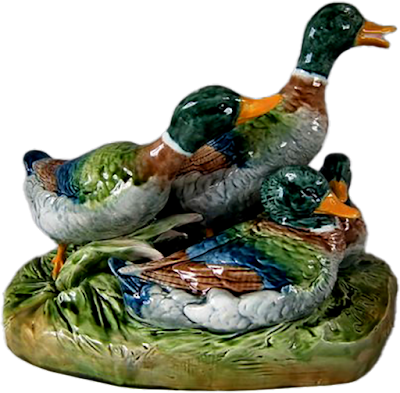Established in 1853 in Dux, Bohemia as Duxer Porzellanmanufaktur, the company initially specialized in the production of simple sanitary and utility ware. In 1860 the pottery came under the control of experienced designer Eduard Eichler who named the pottery after himself, E. Eichler Thonwaren-Fabrik, and purchased anther pottery in Šelty in Česká Lipé to expand the pottery line. The new line included terracotta, porcelain, earthenware and decorative majolica.
The company prospered under Eichler’s ownership until Eichler’s death in 1878. It then came under the direction of Eichler’s widow who took over leadership of the pottery from her husband. She ran it alone until 1890 when her son-in-law Wilhelm Hans joined the company and supplied a much needed infusion of capital. Under his direction the company continued to flourish and entered it’s most successful period.
In 1897 the company became a joint stock company and changed its name to Dux Porzellenmanufter A.C. Further expansion in 1900 was through the purchase of a porcelain factory in Blankenheim, Germany. Corporate headquarters were moved to Berlin and the pottery took the name Royal Dux.
With the decline in popularity of majolica after 1920, Royal Dux’s focus turned to other bodies, mainly porcelain. A succession of owners continued production through the Twentieth century. After WWI and the resulting depression the company headquarters returned to Bohemia, where economic realities caused quality to suffer. Production during WWII declined.
After WWII, Bohemia, Slovakia and Moravia combined to create Czechoslovakia and in 1947 Royal Dux was nationalized. Eichwald Pottery, Royal Dux and Count Thun’s Porcelain Factory were combined and the resulting company was renamed Duchcovsky Porcelain, a name it retained through the Russian occupation.
In 1957 the company merged with Carlsbad Porcelain. The company factory in Duchcov was taken under stock ownership again in 1992 and changed its name to Porcelánová Manufactory Royal Dux Bohemia A.S. The company is now part of Česky Porcelán.
The Royal Dux Bohemia trademark name has remained in continuous use throughout the Twentieth century to present day. Today, Royal Dux mainly produces porcelain, sometimes utilizing prewar molds.
Royal Dux pottery is usually marked. Their most distinctive mark is the pink triangle which started in use c.1860. The mark continued in use through the Twentieth century, both as an applied pad and as an ink mark, joined in 1919 by the phrase Made in Czechoslovakia. This remained in use until the company was taken private in 1990 and the mark changed to Made in the Czech Republic. The mark often included a stylized acorn. A plain text mark has also been used.






























